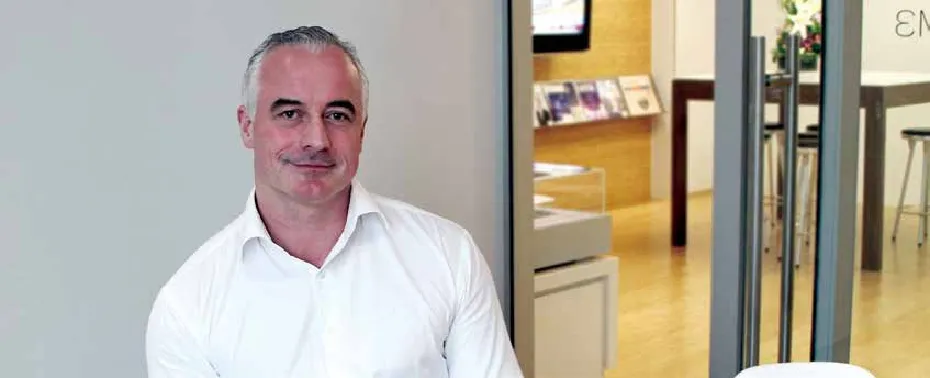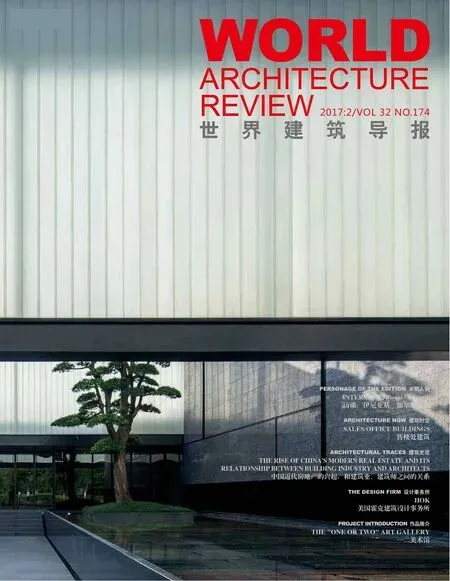HOK董事总经理邝宝麟访谈
HOK董事总经理邝宝麟访谈
Interview with Paul Collins, HOK

HOK董事总经理邝宝麟先生 Paul Collins, Managing Director of HOK
导报:作为HOK亚太区董事总经理,您希望实现什么目标?
邝:HOK在香港及中国大陆的国际化团队在公司 “开放、合作” 的氛围中,共同完成了很多标志性项目。这样的文化和团队对我们的成功起到至关重要的作用。我将继续致力于确保HOK为客户提供卓越的设计和服务,展现HOK在不同专业领域的专业设计能力以及作为全球最顶级的设计公司的核心竞争力。
导报:可持续发展设计在未来HOK的设计中会扮演怎样的角色?
邝:HOK关注可持续发展设计由来已久。过去,可持续设计可能被视作项目的“附加值”,而现在它是设计流程中不可或缺的一个环节。作为人类居住环境的设计领导者之一,我们有义务为社会整合资源、减少能耗,这是我们应该做的事。与此同时,我们这样做,也是帮助客户降低建筑生命周期成本,从而造福客户和整个社会。
导报:您如何评价中国建筑设计行业过去十年的实践?HOK又将如何适应未来中国的发展呢?
邝:经济是具有周期性的。高估市场需求,自然会出现产能过剩、供大于求的现象,这是全球房地产业共通的情况。中国市场需要时间来吸收这些过剩的住宅、办公建筑,发展自然而然就会转移到一些相对短缺的建筑类别,比如酒店、医院、体育场馆等来填补市场空缺。我们的战略就是通过增强我们在更广泛的领域的设计能力来应对挑战和快速变化的市场需求。
接下来的几年内,新的住宅或者商业类项目肯定会减少,而旧建筑改建类项目一定会有很大的市场需求。老建筑的翻新和改建将成为可持续设计创新的孵化器。接下来的10年,中国的建设总量会减少,因为过去的10年间中国房屋的建设速度和数量都很惊人。用高性能的材料和其他高效节能的机械系统来改造部分老建筑,可以达到节能和环保的目的,也更容易吸引买家和投资者。
中国正面临严峻的环境问题,可以说正处在一个十字路口。过去的中国大力发展基础设施,住宅和商业地产。此刻,我们可以集中精力改善环境,大力贯彻可持续发展设计规范。
导报:在这个多元化的建筑设计市场里,HOK独有的优势是什么?
邝:多样性是HOK在20世纪50年代创始之初的基本信条之一,体现在项目地理位置、项目种类和员工专业性等各方面,而我们认为其中最重要的是思想的多样性。HOK全球23间办公室的员工来自世界各地,为我们带来了截然不同的宝贵的专业背景和个人经验。
HOK香港和中国大陆办公室的员工也不例外。这种多元化和丰富性成为了我们公司文化最重要的组成。所以当我们和中国的客户讨论一个购物中心、一座体育场、一间酒店的时候,我们带给他们的是全球的视野和集体的经验。世界上没有多少公司能够在设计问题上提供像HOK这样百科全书类的解答。如果说多样性是HOK的投入,那创新就是投入之后的产出。专业知识本身不一定能够创新,但当我们把不同背景和经验的人组织在一起共同应对一个挑战的时候,往往能擦出火花,创造出与众不同的解决方案。
导报:最近HOK在忙些什么项目呢?
邝:HOK的项目在地理位置和类型上都具有多样性。我们的规划团队目前正忙于北京和成都的两个旅游度假项目,以及深圳的两个城市更新和产业园区项目。
我们建筑团队正在设计的项目包含成都核心区的一个大型超高层综合体项目,三亚和深圳的几个高端度假酒店,印度德里的一个顶级豪宅和孟买的一个科技园区。我们同时在中国、中东和缅甸有几个五星级酒店及服务式公寓的室内设计工作正在开展。而我们的景观团队则忙碌在天津、三亚和厦门的项目中。当然,我们还有更多的项目,在这里不一一例举。
导报:如果没有预算和设计要求限制,你觉得“理想中的项目”是怎样的?
邝:我认为“理想中的项目”应该是一个能够将HOK全球的设计资源和能力运用到一处的一个项目。沙特阿拉伯的阿卜杜拉国王科技大学就是个很好的例子。HOK是在2006年底被委托设计总面积达650万平方英尺的大学新城的,而到2009年在不到3年的时间里该项目就完成了施工并如期开学,这一速度堪称世界壮举!
当时我们动员了HOK全球不同时区的多个办公室同时工作,这样可以将每天8小时的工作时间延长到16小时。通过整合HOK全球多地的资源和专业力量,我们成功为该项目提供了从总体规划、建筑设计、工程设计、景观设计、室内设计到设施规划、实验室规划、平面设计及灯光设计的一系列全专业服务。最终,我们不仅打造了一个世界级的高端大学园区经典,它还获得LEED白金认证。
在如此短的时间内建成如此体量浩大的工程,只有具有HOK这般人员规模、专业实力和全球网络的公司才能胜任。我理想中的项目应该是类似的——体量大、复杂程度高、具有各种挑战性—— 这正是HOK所擅长的!
WARA: As managing director for HOK in Asia Pacific, what do you hope to achieve?
Collins: We have a large practice of international designers based in Hong Kong and China that work well together on signifcant projects. The collaborative nature of our team members and open environment in our ofces are essential to our success. I will ensure that we maintain these critical aspects of our culture. And I’ll be ensuring that we provide exceptional design and delivery services that demonstrate HOK’s multidisciplinary expertise as one of the world’s best design frms.
WARA: What role will sustainable design play in HOK’s future?
Collins: Sustainable design has been at the center of much of HOK’s work for many years. In the past, it may have been perceived by clients as an add-on. Today, sustainable design is simply part of our design process. As one of the leading designers of the built environment, we have a responsibility to help our society manage resources efciently, reduce waste and decrease energy consumption. Of course this is the right thing to do. It also brings great value to our clients in terms of reducing life-cycle costs and providing healthy environments that promote the well-being of their people and communities.
WARA: How would you review the design industry in China over the last 10 years? How does HOK ft into the future of development in China?
Collins: The economy is cyclical. The tendency to overestimate a demand in the market and then to design and build more buildings than needed is a recurring phenomenon across the world. As the Chinese market absorbs over-supplied residential and ofce buildings, development will shift to other building types like hotels, hospitals or sports venues where there is still a shortfall. Our strategy has been to maintain high-quality design and key expertise in a wide variety of building types. This enables us to quickly respond to these shifts in demand.
While there will be a reduced demand for new residential and commercial construction over the next few years, there is an opportunity to renovate existing buildings. Renovating and repurposing buildings helps drive sustainable design innovation. In the next decade, China’s existing building stock will face decay in part because so much was built so quickly over the previous 30 years. Retroftting old buildings with high-performance materials and energy-efcient mechanical systems will reduce energy consumption and pollution while making buildings more comfortable for users and more attractive for investors.
China is at an environmental crossroads. The country previously was mobilized to develop infrastructure, housing and commercial real estate at a very rapid pace. Now we can focus on improving the environment through an equally aggressive enforcement of sustainable design principles.
WARA: In this diverse architectural design market, what makes HOK unique?
Collins: Diversity was one of HOK’s founding principles in the 1950s. This includes diversity of geography, projects, services staff and, most importantly, diversity of thinking. The people who make up HOK’s 23 global ofces come from all over the world and bring incredibly varied professional and personal experiences.
Our people in China and Hong Kong are no exception. This variety and richness are the main ingredients of our culture. When we talk to clients here about a mall, stadium or hotel, we speak from our global experience. Not many frms in the world can bring this encyclopedic knowledge to a client’s design problem. If diversity is the input, innovation is the output. Our deep expertise alone will not create innovation. But when we bring together people with diferent backgrounds and experiences to work toward a common goal, we can create innovative design solutions.
WARA: What are you working on now?
Collins: Our projects are diverse in nature and location. Our planning team is working on tourism development projects in Beijing and Chengdu. They are also developing two urban regeneration and industrial park projects in Shenzhen.
The architectural team is engaged on a major high-rise mixed-use project in central Chengdu, resorts in Sanya and Shenzhen, a luxury residential apartment in Delhi and an IT park in Mumbai. We’re providing interior design services on several fvestar hotel and serviced apartment projects in China, the Middle East and Myanmar. Our landscape architects are busy in Tianjin, Xiamen and Sanya. That’s far from the whole list but is a sampling of what we do.
WARA: What would your dream project be – if you had no budget restrictions and full creative license?
Collins: My dream project would be one where we could use the full global capabilities of HOK for a single project. The King Abdullah University of Science and Technology (KAUST) in Saudi Arabia is a perfect example. We were commissioned to design this 6.5-million-sq.-ft. university and new town project toward the end of 2006 and it was completed and opened by 2009.
The pace of design was so fast that we collaborated with several HOK offices spread out in diferent time zones (from London to San Francisco) so that our working day was closer to 16 hours than eight hours. We used nearly every resource in the frm and provided planning, architecture, engineering, landscape architecture, facility planning, interior design, lab planning, graphic design and lighting design services. This collaborative process resulted in a wonderful new science and education campus that achieved LEED Platinum status.
Only a frm with the scale, experience and connectivity of HOK can deliver a project like KAUST. My dream project would be something similar to that: very large and complicated with lots of pressure. That’s when we excel!

班加罗尔国际机场一号航站楼扩建 Kempegowda International Airport, Bengaluru Terminal 1 Expansion

